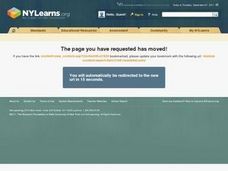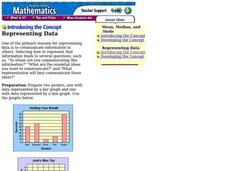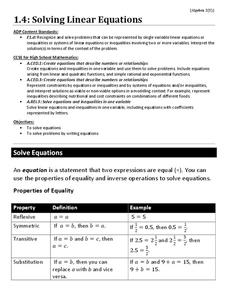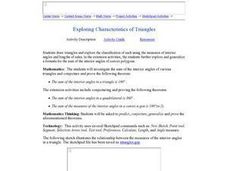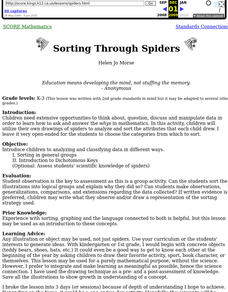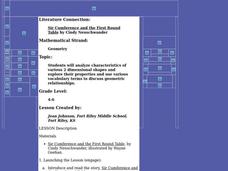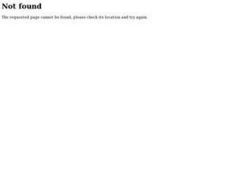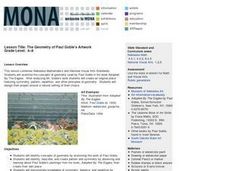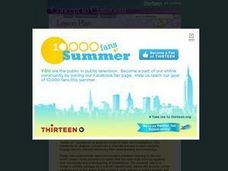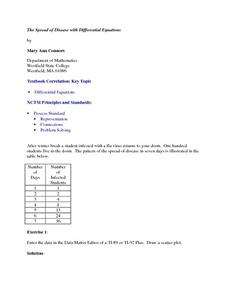Curated OER
Ratios: Interpreting the Phrase "Out Of"
Students explore the concept of ratios. They observe a website of Trident Gum that gives a real life example of ratios. Students practice ratio problems in three forms. They express ratios as a proportion and solve proportions using...
Curated OER
Children's Literature Across the Curriculum Ideas-Hanukkah Lights, Hanukkah Nights
Students read Hanukkah Lights, Hanukkah Nights by Leslie Himmelman. They complete a variety of cross-curricular activities surrounding the study of Hanukkah. Included are reading, art, math, science, writing, social studies, and library...
Curated OER
Representing Data
Second and third graders answer questions based on data presented to them in graphs. They see how to interpret data from a bar graph, line graph, and a chart.
Curated OER
How Much Is A Million
Help young learners visualize the concept of "a million." To convey concepts of numeration and literacy, they will listen to the book How Much is a Million? by David Schwartz. They should be able to make self-to-text connections....
Concord Consortium
Filling the Pool
Fill your mind with math as you think about filling a pool. Given information about the rates of two pipes, one filling a pool and one draining a pool, learners determine a piecewise function that models the volume of water in the pool...
Curated OER
Solving Linear Equations
Use this learning exercise for practice or review solving linear equations in one variable. Problems range from multiple-step problems involving parentheses and combining like terms, to word problems, to equations with no solution or...
Curated OER
#3 Differential Calculus
Students create models of the Mean Value Theorem. In this Mean Value lesson, students use their knowledge of derivatives and exponential functions to explore the Mean Value Theorem. They illustrate the meaning of the throrem,...
Curated OER
Fast Food Survey Using Bar Graphs
Second graders create a bar graph to pictorically represent the data collected from a survey of students. They use Excel to electronically create the graphs and data tallies. They then interpret their data using sentences to explain.
Curated OER
Analyze This
Students gain practice in the analysis of various types of graphs common in daily life. These examples often use graphic images like charts, graphs, tables, and pictures to supplement learning.
Curated OER
Navigating by the Numbers
Students observe how math is important in navigation and engineering. They study how surveyors use math and science to calcute, count, measure, label, and indicate distances on a map. They estimate specific distances.
Curated OER
Exploring Characteristics of Triangles
Young scholars draw triangles and explore the classification of each using the measures of interior angles and lengths of sides. They investigate the sum of the interior angles of various triangles and conjecture and prove the theorem:...
Curated OER
The Pythagorean Theorem
Students create both a visual and formal proof of the Pythagorean theorem, as well as view four additional geometric demonstrations of the theorem. They construct a square and conjecture the following theorem: The sum of the areas of...
Curated OER
Sorting Through Spiders
Young scholars utilize their own drawings of spiders to analyze and sort the attributes that each student drew.
Curated OER
"Sir Cumference and the First Round Table" by Cindy Neuschwander
Students analyze characteristics of various 2 dimensional shapes and explore their properties and use various vocabulary terms to discuss geometric relationships.
Curated OER
A Remainder of One: A Math-Manipulative Lesson
Students listen to the reading of the book "A Remainder of One" and use math manipulatives to recreat "bug squadrons".
Curated OER
Personal Development - Setting Goals to Achieve Objectives
Students explore reasons for setting goals and techniques to achieve them. They discover the importance of setting goals, both short-range and long-range. Students assess their own situation and write specific goals to meet their...
Curated OER
A Financial Flower Garden
Students study about the US Botanic Garden in Washington, D.C. Students build their own class botanical garden. Students offer multiplication skills to the building of their own garden.
Curated OER
The Geometry of Paul Goble's Artwork
Students examine the concepts of geometry used by Paul Goble in his book Adopted By The Eagles. After analyzing Mr. Goble's work they create an original piece featuring symmetry, pattern, repetition, and other principles of geometry....
Curated OER
Why is this lesson constructivist?
Students formulate a definition of tessellations by comparing and contrasting different patterns and shapes of real objects. They discuss the relatioship between shapes and patterns as well as their function in the real world. Students...
Curated OER
The Spread of Disease with Differential Equations
Twelfth graders solve problems using differential equations. In this Calculus lesson, 12th graders analyze data regarding the spread of a flu virus. Students use the symbolic capacity of the TI-89 to develop a model and...
Curated OER
Gummy Bear Math
First graders predict, collect data, and create a graph based on gummy bear colors they are given. In this graphing lesson plan, 1st graders first predict how many colors of gummy bears there are. They then count the colors, graph them,...
Curated OER
Chinese Inventions
Students identify inventions as coming from China. In this Chinese inventions lesson, students are given a list of common items such as cast iron, a wheelbarrow, and the decimal system, then conduct research to identify where they were...
Curated OER
Quilts and Math
Students create a pattern. In this patterns lesson, students review the meaning of symmetry and explore using pattern blocks. Students look for patterns in real quilts, photographs and pictures. Students work independently to plan a...
Curated OER
Vocabulary: Addition Terminology
In this addition terminology instructional activity, students complete many activities where they define and match addition terminology. Students complete 11 pages of activities.
